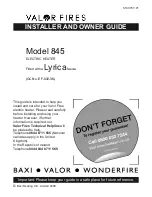
LP-314 Rev. 012 Rel. 003 Date 9.27.19
47
The appliance requires minimal periodic maintenance under normal
conditions. However, in unusually dirty or dusty conditions, periodic
vacuuming of the cover to maintain visibility of the display and
indicators is recommended.
Periodic maintenance should be performed once a year by a
qualified service technician to assure that all the equipment is
operating safely and efficiently. The owner should make necessary
arrangements with a qualified heating contractor for periodic
maintenance of the appliance. The installer must also inform the
owner that the lack of proper care and maintenance of the appliance
may result in a hazardous condition.
It is extremely important that whenever work is performed on the
plumbing system that either:
• The appliance is powered off, or,
• The appliance is valved off and isolated from the plumbing
system.
Failure to take these measures could result in a dry-firing condition.
The appliance must be full of water and the system fully purged
BEFORE powering the appliance. Performing any work in the
plumbing system without either powering off the appliance or
isolating the appliance through the use of shut-off valves could
result in a condition referred to as “dry-firing”. Dry-firing the
appliance will damage the heat exchanger, and could result in
property damage, serious personal injury, or death. Such damages
ARE NOT covered by appliance warranty.
Outdoor Sensor
(7250P-319)
Upper Sensor (7100P-004)
Lower Sensor (7100P-005)
Clip-On Sensor (7100P-172)
Outside
Temperature
(
o
F)
Resistance
(ohms)
High / Low
Temp Sensor
Temp. (
o
F)
Resistance
(Ohms)
-22
171800
32
32550
-13
129800
41
25340
-4
98930
50
19870
5
76020
59
15700
14
58880
68
12490
23
45950
77
10000
32
36130
86
8059
41
28600
95
6535
50
22800
104
5330
59
18300
113
4372
68
14770
122
3605
77
12000
131
2989
86
9804
140
2490
95
8054
149
2084
104
6652
158
1753
113
5522
167
1481
176
1256
185
1070
194
915
202
786
212
667
Table 22 - Sensor Temperature Resistance
Part 13 - Shutdown
A. Shutdown Procedure
If the burner is not operating, disconnect the electrical supply.
If the burner is operating, lower the set point value to 70
o
F and wait
for the burner to shut off. Continue to wait for the combustion blower
to stop, so all latent combustion gases are purged from the system.
This should take a maximum of 40 to 90 seconds. After combustion
gases are purged turn off electrical power to the appliance.
B. Vacation Procedure
If there is danger of freezing, change the set point to 70
o
F. DO NOT
turn off electrical power. If there is no danger of freezing, follow
“Shutdown Procedure”.
C. Failure to Operate
Should the burner fail to light, the control will perform two more
ignition trials prior to entering a lockout state. Note that each
subsequent ignition trial will not occur immediately. After a failed
ignition trial, the blower must run for approximately 10 seconds to
purge the system. Therefore, a time period of approximately 40 to 90
seconds will expire between each ignition trial.
If the burner lights during any one of these three ignition trials,
normal operation will resume. If the burner lights, but goes off in
about 4 seconds, check the polarity of the wiring. See electrical
connection section of this manual.
If the burner does not light after the third ignition trial, the control
will enter a lockout state. This lockout state indicates that a problem
exists with the appliance, the controls, or the gas supply. Under such
circumstances, a qualified service technician should be contacted
immediately to properly service the appliance and correct the
problem.
If a technician is not available, pressing
RESET
will remove the
lockout state so additional trials for ignition can be performed. The
unit will try to relight once every 6 minutes.
D. Important Notice
It is extremely important that whenever work is performed on the
plumbing system that either:
• The appliance is powered off, or,
• The appliance is valved off and isolated from the plumbing
system.
Failure to take these measures could result in a dry-firing condition.











































